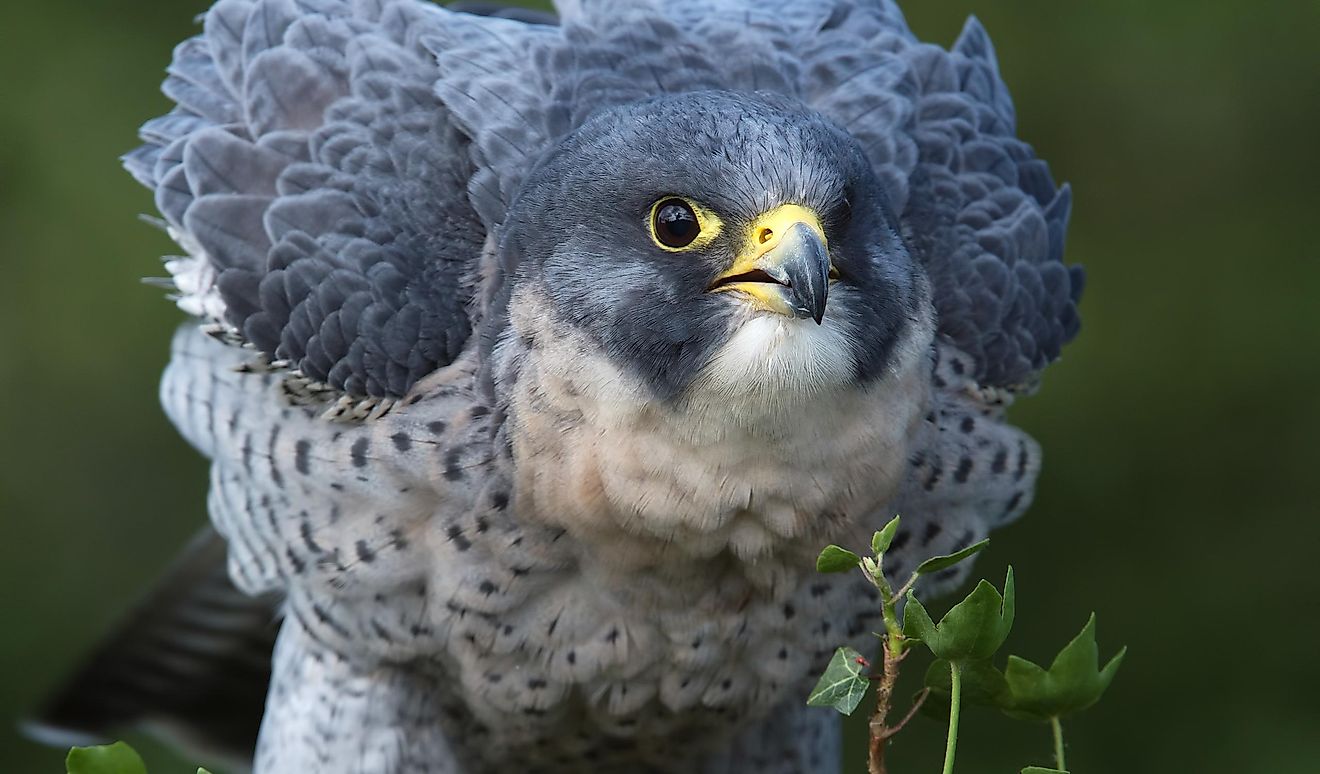Peregrine Falcon Facts: Animals of North America

5. Physical Description
The Peregrine Falcon is a bird of prey with long, broad, pointed wings, and a short tail. Its eye socket and the upper parts of its beak are yellow. The feathers on their upper bodies have a blue-grey appearance, and the ones on their heads are black. Their lower body feathers are white, though often stained by some grey. When mature, the peregrine falcon has a wingspan of between 3.3 and 3.6 feet (1 to 1.1 meters), and a body size of 14.4 to 19.2 inches (36 to 49 centimeters). Its weight ranges from 1.2 and 3.5 pounds (0.53 to 1.6 kilograms). According to National Geographic, there are around 19 known subspecies of the Peregrine falcon living today.
4. Diet
The peregrine falcon feeds on bats and other birds, including doves, waterfowl, feral pigeons, small songbirds, and grouses. To hunt, the peregrine falcon first spots its prey from a distance using its keen vision. Then it stoops, and subsequently dives at speeds in excess of 200 miles per hour, catching another bird in midflight. To enable the peregrine falcon to breath at such a rate of speed, it has baffles (cone shaped bones) in its nostrils which help it to control its respiration. If peregrine falcons fail to catch their prey on the wing in their high speed stoops, they can become injured themselves . They also conduct surprise hunting attacks, wherein they will snatch their prey from off the ground or from right off of one of the smaller birds' perches.
3. Habitat and Range
The peregrine falcon lives on all continents except for Antarctica. It can thrive in coastal areas, tropical forests, mountains, near deserts, and even close to cities. Except for when they are very young, adult peregrine falcons do not typically face any real threat from humans nor from natural predators. During the years following World War II, illegal hunting, and the rampant use of the pesticide DDT, caused their populations to diminish, according to the Nature Conservancy. By the middle of the 1970s, the Peregrine falcon population across the Western US had bee reduced by 90 percent. Since then, however, the ban on DDT and other conservation measures has allowed for a marked increase in the birds' populations. Today, it’s estimated that there are 1,650 breeding pairs in the US and Canada. In fact, 1999 was the year that saw peregrine falcons removed from the Federal "List of Endangered Species" in the US.
2. Behavior
Peregrine falcon are "diurnal", meaning they are typically most active during the daylight hours. Except when breeding, the Peregrine falcon lives in isolation, within a territory it has established the bounds of itself, and subsequently defends the spaces therein ferociously. The Peregrine falcon is an apex predators, having no natural predators itself. The span of the territory a Peregrine falcon establishes depends on the availability of food resources and the population of other predatory birds in the region.The spacing of their nests range from being between 2 and 3.5 miles (3.3 and 5.6 kilometers) apart from one another. Some of them migrate, while others stay in their natural habitats permanently, again being dependent upon geographical location and clime.The peregrine falcon has an average lifespan of 13 years, but some have been reported to have lived to reach 25 years-old. After death, their nests will continue being used by successive generations, sometimes for many years.
1. Reproduction
To reproduce, the peregrine falcon pairs with a mate throughout the mating season, which typically lasts from late March until May. The male falcon puts on a display at nest ledges to attract females. Thereafter, when a pairing has been made, a bond is formed by the male and female, who begin roosting close to one another.The male and female sit side by side at the nest ledge. They will often stare and poke at each other and, of course, mate. Before eggs are laid, the pairs will carry out aerial displays, including body rolls. With their bonds cemented, they will together hunt as pairs. After the eggs are laid, both male and female will help to incubate the 3 to 4 eggs for around a month, at which time the young peregrines hatch.











